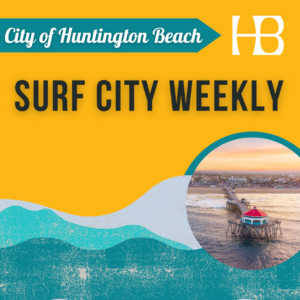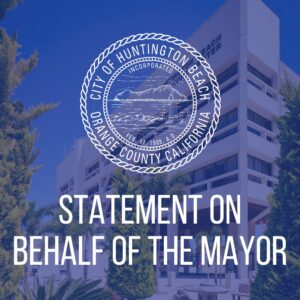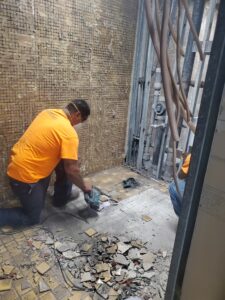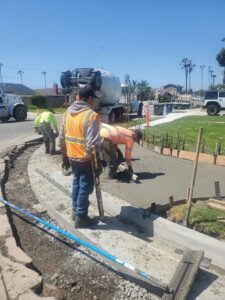Written by City Archivist, Kathie Schey
The story of Henry Huntington’s Pacific Electric Railway, although not the man himself, rolling into town on July 4, 1904, is legendary. The “Red Car” had arrived! Although the event signaled an exciting future for our then-small town, it was not the beginning of the Pacific Electric or even the beginning of the railroad in Huntington Beach.
Industrial titan Collis Huntington headed the development of the Southern Pacific Railroad (SPRR), leading efforts in the East while his nephew and heir, Henry, did so from his home in California. Henry, surprisingly, did not succeed his uncle as head of the SPRR (although he later did acquire his uncle’s much younger wife, Arabella). Henry founded his rail line in 1901 – the Pacific Electric – incorporating various existing electric trolley lines in Los Angeles. While the steam-powered SPRR had focused on freight, the Pacific Electric (PE) focused on passenger transportation. It proved a forward-thinking and successful idea in our ever-growing region.
However, by the time the PE line reached Huntington Beach, the Southern Pacific was already a key to the region’s economic future, which was based almost completely on agriculture. Featured prominently in the earliest detailed map of the City prepared by S.H. Finley when we were still Pacific City in 1903, the SPRR line runs along the now long-gone Cate Avenue before heading to Newport Beach. The SPRR focused on freight. One early order placed by our City fathers was for an entire carload of gravel intended to fill all the potholes on our largely dirt City streets. It proved only enough to fill those on the first block of Main Street.
The two lines vied for several years following the Red Cars’ arrival in 1904, with the PE originally focused on passenger service. The Pacific Electric quickly gained ground. A new depot was planned downtown, and the powerful relationship between the Huntington Beach Co., designated developers of the community, and the PE was clear. Newspaper accounts described the authority given by the PE to the Huntington Beach Co. to decide where the line should next run. Anaheim fought tirelessly against Santa Ana for the privilege, noting how the county seat had treated many Orange County cities, including Huntington Beach. At one time, Huntington Beach had threatened to rejoin Los Angeles County as a result. Pronounced “a nail in the coffin of Huntington Beach,” should a Santa Ana route be chosen, our “scrappy little town” was championed for its resistance. Although the Huntington Beach Co. originally endorsed an Anaheim terminus, Santa Ana was eventually selected.
The PE and SPRR lines’ target markets became mingled. When the Holly Sugar Plant, an early prominent factory, opened in 1910, a dedicated PE spur was laid in to support it. In 1911, the Pacific Electric and the SPRR combined in what has been called “The Great Merger.” Following this, each of the rail lines reached our important industries, including tile factories, a canning plant, and more – cementing development in our city. The celery, cabbages, beets, and livestock produced by towns like Smeltzer and Wintersburg – now all part of Huntington Beach – were shipped to eager eastern markets. New residents and tourists traveled by train, leading to population growth. The advantages offered by the service of both were widely touted as advantages of living here.
The human story of the rail lines was not without some sorrow. In 1914, Miss Eva Preston was struck and killed at the Depot. On a foggy, rainy night, she alighted from the train. Attempting to cross the tracks, she did not see the muted red lantern shone by an oncoming car in the fog or hear the sound of the oncoming electric car amidst the sound of rain. She was only 22 years old.
Still, many other stories are left to us that celebrate the rails. In 1923, our Boy Scout Troop I received telephone poles to build their Scout Cabin, still used in Lake Park. The poles were delivered by the SPRR tracks, which ran so closely nearby that Lake Street was at one point named “Railroad Avenue.” Years later, a young Alicia Wentworth, our first female City Clerk, arrived shortly after WWII with her sister’s family. She recalled her early working years boarding the Red Car for her first job in Los Angeles. It cost her 10 cents each way!
Today, the Pacific Electric trolley tracks crossing Main Street and running along Pacific Coast Highway are long gone. The 1909 Santa Ana-Huntington Beach route was long disused and abandoned in 1922. Other routes survived, albeit briefly. The track south of Wintersburg, abandoned by the SPRR in 1933, was resurrected for a short while by the Pacific Electric in 1948. By 1993, all vestiges of these early lines were gone.








